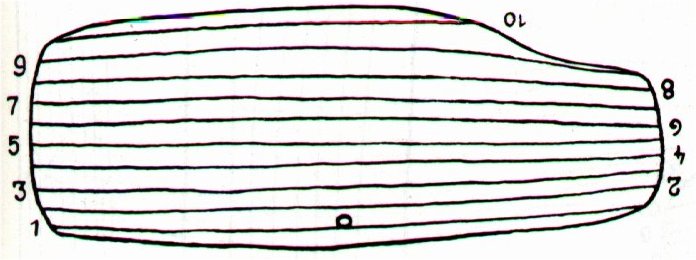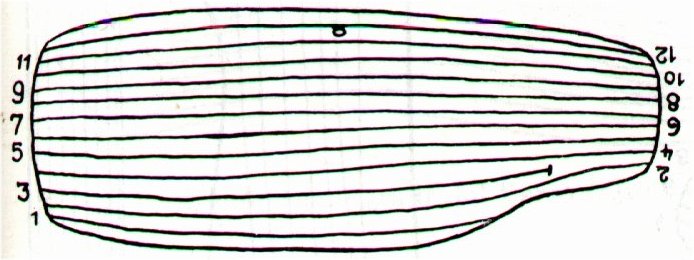|
TRANSLATIONS
The text on Aruku Kurenga is curiously disposed, there are 12 lines of glyphs on side b but only 10 on side a. Maybe side b is the dark side and side a the sunny side? There seems to be no obvious other reason for having only 10 lines of glyphs on side a:
On side a the number of glyphs per line alternates regularly between odd and even, whereas on side b the pattern is more irregular ('dark'). Once again side b appears to represent the 'night'. 421 + 506 = 927 = 9 * 103 = 3 * 314 - 15 = 2 * 360 + 209. No obvious pattern connected with π or 360 is seen. 421 is one more than 420. 506 = 420 + 2 * (42 + 1). 927 = 2 * 420 + 3 * 29. Not very convincing either. There are 5 odd-number glyph lines on side a and 6 on side b (and an equal number of even number glyph lines).
219 = 3 * 73 and 256 = 16 * 16. 469 = 7 * 67 and 458 = 2 * 229 = 314 + 12 * 12. Nothing obvious. Dividing the lines in the middle may give some hints though: there are 4 lines with 40 glyphs and they are all located in the first half of the sides (a2, a4, b5, b6) - red above. A corresponding odd number could be 43 with 4 lines located in all the halves of the sides (a5, a5, b3, b11) - black above. The interpretation of this pattern (if it is not a coincidence) seems to be that 'black' (the odd number 43 - one more than 42) has a part everywhere during the year, whereas 'red' (the even number 40 - twice 20) is seen only in the first halves of the sides. Consequently, side b is not the dark side (in contrast to side a). The dark appears in the 2nd halves of both side a and b. The middle of both sides could represent the autumn equinoxes. If the middle of both sides of Aruku Kurenga are located at autumn equinox, then we would expect the same pattern on Tahua and indeed we find hua (GD51, the sign of ripe fruits) combined with rei (GD13, a sign of the king?):
The skull of a dead king could be symbolically represented by hua respective rei miro: 'Up to the present time, fertility spells for fowls have played an important role. Especially effective were the so-called 'chicken skulls' (puoko moa) - that is, the skulls of dead chiefs, often marked by incisions, that were considered a source of mana. Their task is explained as follows: 'The skulls of the chiefs are for the chicken, so that thousands may be born' (te puoko ariki mo te moa, mo topa o te piere) (Englert 1939:240). As long as the source of mana is kept in the house, the hens are impregnated (he rei te moa i te uha), they lay eggs (he ne'ine'i te uha i te mamari), and the chicks are hatched (he topa te maanga). After a period of time, the beneficial skull has to be removed, because otherwise the hens become exhausted from laying eggs ...' However, other signs seem to tell us that side a (or at least the glyph sequence Aa4-63 -- 72 above) is another season than what can be read on side b (Ab5-1 -- 10). First we should consider that hau tea (GD41) appear to indicate more light on side a than on side b:
Aa4-70 is broader and has the vertical outer lines spreading out, which I read as more light. To see whether this sign of light appears everywhere on side a but never on side b we can make an extract from the glyph catalogue:
Yes, the broad spreading out light is seen only in the 1st 'quarter' (lines a1-a4). In the 2nd 'quarter (lines a5-a8) we may read waning light in Aa5-5 and Aa5-63. At the end of the '2nd quarter' we find two glyphs (Aa7-79 and Aa8-51) with poor light. On side b there is poor light all the way through the 3rd 'quarter' (lines b1-b4). In the 4th 'quarter' (lines b5-b8) there is a less clear message. The double 'suns' (Aa7-79 and Ab4-49) are located with 8 glyphs between them. Perhaps Aa7-79 stands at winter solstice - we notice an extremely long straight vertical middle line, and the double 'suns' could represent old and new year. We can try to coordinate Aa1-1--12 with the hau tea glyphs on side a:
The results are surprisingly promising. We have, though, to revise the meaning of the 'double-sun' hau tea, it does not seem to stand at winter solstice but at autumn equinox (or when the Pleiades become visible again - the 'double-sun' maybe allude to mata in Matariki). Spring equinox appears (presumably) as two extraordinarily big hau tea (Aa3-32 and Aa4-18). Aa2-74 and Aa3-15 have the 'roof' closed (not open at left as all the rest of the glyphs - except Aa7-79 and Aa8-51), which maybe tells us about darkness ruling in spite of the new year. From 'autumn equinox' (the rising of the Pleiades) and up to spring equinox sun is absent. The head in Aa1-11 alludes (perhaps) to hua - the skull of the sun 'chief' is like a fruit which will fall and give new life next year. Matariki may therefore be understood as mata - ariki (the 'face' - or head - of the sun king is 'cut off and buried in the ground'). In Aa4-72 the break (koti) between old and new year can be read as the gap between GD53 (left) and GD59 (right):
We recognize the same gap sign as in Aa1-15:
There presumably is a similarity in meaning between GD53 (maitaki, beautiful) and GD29 (va'e, leg), and we remember:
|
|||||||||||||||||||||||||||||||||||||||||||||||||||||||||||||||||||||||||||||||||||||||||||||||||||||||||||||||||||||||||||||||||||||||||||||||||||||||||||||||||||||||||||||||||||||||||||||||||||||||||||||||||||||||||||||||||||||||














